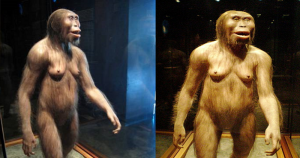
Google Doodle Celebrates Discovery of Most Popular Early Human Ancestor ‘Lucy’
Google is remarkably known for its unique creations and Google Doodle is one such innovative thought. Google Doodle is a temporary alteration of the logo on its homepage that is decorated with a doodle to celebrate special events, occasions and many more. As part of such special event, Google today celebrates the 41st anniversary of Lucy, the world’s famous oldest hominid with a special doodle. November 24 is a remarkable day on which the discovery of Lucy’s skeletal remains were made.

Lucy Australopithecus is the world’s famous oldest human ancestor, who is proven to have lived around 3.2 million years ago in Ethiopia. Today, Google celebrated the discovery of the fossilised remains showing the three stages of Lucy’s evolution in place of ‘oo’ in the word ‘Google.’ The discovery of the fossilised remains of Lucy was made in the year 1974.
Who is Lucy the Australopithecus?
Lucy was the first Australopithecus afarensis skeleton ever found in the history of mankind though her fossils are only about 40 percent. Australopithecus afarensis is a defunct hominid that lived between 3.9 and 2.9 million years ago. 41 years ago, a team of archaeologists working in Ethiopia discovered the remnants of an ancient skeleton that became an essential missing part in the mystery of how humans came to be. The skeletal remains of that ancient female hominid were only about 40%.

The skeleton was nicknamed as “Lucy” by a paleoanthropologist Donald Johanson after the Beatles song ‘Lucy in the Sky with Diamonds.’ It was also found that the skeleton was dated at 3.2 million years old and it can be set as an oldest known example of a bipedal primate. Lucy had become a significant stepping stone between apes and homo sapiens.
Discovery of Lucy
In the year 1974, archaeologists Donald Johanson and Tom Gray found 47 bones of Lucy providing them adequate information about the species to help understand the transition to homo sapiens. Based on the skeleton’s pelvis structure, they had come to a conclusion that it was female and named it as “Lucy”. At that time, Lucy in the Sky With Diamonds, the Beatles song was playing back at their camp and so they named it as Lucy.
Lucy had many similarities with chimpanzees, such as long arms and a protruding belly. However, the skeleton revealed that she primarily walked upright which sets as the earliest example of such a primate. Bipedalism is seen as one of the key contrasts between Homo sapiens and Pan, which was considered as the family of chimpanzee species.
Physical Appearance of Lucy
According to National Geographic, with a mixture of ape and human features that was comprised of long dangling arms but pelvic, spine, foot, and leg bones suited to walking upright. All these features prove that the thin Lucy stood three-and-a-half feet tall. Lucy was found to be only 3.7ft tall and weighed just 29kg. Her wisdom teeth were mostly similar to humans which were exposed and appear to have been in use for a while before her death. Several factors point to Lucy being fully grown.
She died as a young but fully grown adult. Her fossilised bones were carbon dated to be 3.2 million years old and were unique because most of her counterpart’s skeletons were usually incomplete and damaged. Because of Lucy, it has become possible for the scientists to learn a lot about the evolution of the human species. Thanks to Lucy, the oldest human ancestor which revealed many interesting and unknown facts of human evolution.
Till now, it is not known that how Lucy died, but the sections of her skull were separated in children and had grown together. Currently, the fossilised remains of Lucy’s bones are kept in a specially-constructed safe in the National Museum of Ethiopia in Addis Ababa.